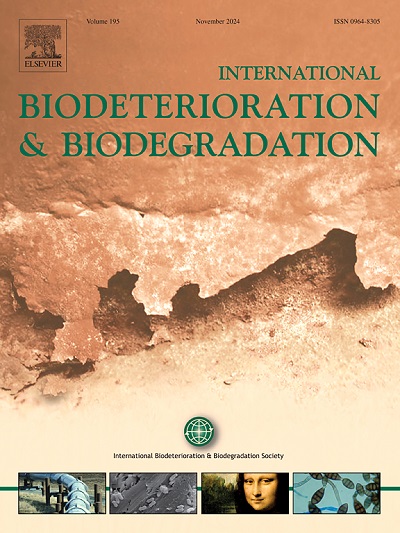Assessment of glutaraldehyde and formaldehyde for enhancing decay resistance and reducing caffeine leachability in Scots pine wood
IF 4.1
2区 环境科学与生态学
Q2 BIOTECHNOLOGY & APPLIED MICROBIOLOGY
International Biodeterioration & Biodegradation
Pub Date : 2025-02-01
DOI:10.1016/j.ibiod.2025.106014
引用次数: 0
Abstract
Caffeine-treated wood is valued for its decay resistance, but caffeine high leachability under outdoor conditions significantly reduces its long-term effectiveness. This study aimed to mitigate the leachability of caffeine-impregnated Scots pine wood by incorporating either formaldehyde or glutaraldehyde. The treatments were evaluated using standard leachability analysis (EN 84), decay resistance testing (EN 113), mass spectrometry, attenuated total reflectance Fourier transform infrared (ATR-FTIR) spectroscopy, and mechanical testing. Leaching tests revealed that caffeine-glutaraldehyde-impregnated wood exhibited the lowest mass loss after leaching (3.30 ± 0.15%), outperforming caffeine-treated (6.18 ± 0.15%) and caffeine-formaldehyde-treated (5.94 ± 0.13%) specimens, indicating superior caffeine fixation. ATR-FTIR spectroscopy showed that characteristic caffeine bands diminished following leaching, confirming caffeine leachability. However, caffeine-glutaraldehyde-treated samples exhibited less pronounced spectral changes compared to caffeine-formaldehyde-treated samples. Mass spectrometry further corroborated these findings, detecting higher caffeine content in glutaraldehyde-treated wood than in caffeine-only specimens after leaching test. Decay resistance tests demonstrated that caffeine-glutaraldehyde-treated wood retained high resistance to fungal decay both before and after leaching. Mechanical tests revealed that the modulus of rupture (MOR) was preserved post-leaching only in caffeine-glutaraldehyde-treated samples. These findings highlight the effectiveness of low concentrations of glutaraldehyde in reducing caffeine leachability, thereby enhancing the decay resistance and durability of treated wood, making it a promising approach for outdoor applications.
戊二醛和甲醛增强苏格兰松木抗腐性和降低咖啡因浸出性的评价
经咖啡因处理的木材因其耐腐性而受到重视,但咖啡因在室外条件下的高浸出性大大降低了其长期有效性。本研究旨在通过掺入甲醛或戊二醛来减轻咖啡因浸渍苏格兰松木的浸出性。采用标准浸出性分析(EN 84)、耐腐性测试(EN 113)、质谱分析、衰减全反射傅立叶变换红外(ATR-FTIR)光谱和力学测试对处理进行评估。浸出试验表明,咖啡因-戊二醛浸渍的木材在浸出后的质量损失最低(3.30±0.15%),优于咖啡因处理(6.18±0.15%)和咖啡因-甲醛处理(5.94±0.13%)的样品,表明咖啡因的固定作用更强。ATR-FTIR光谱分析表明,浸出后咖啡因特征谱带减弱,证实了咖啡因的浸出性。然而,与咖啡因-甲醛处理的样品相比,咖啡因-戊二醛处理的样品表现出较少明显的光谱变化。质谱法进一步证实了这些发现,在浸出试验后,检测到戊二醛处理过的木材中咖啡因含量高于仅含咖啡因的样品。抗腐性试验表明,经咖啡因-戊二醛处理的木材在浸出前后都具有较高的抗真菌性。力学试验表明,断裂模量(MOR)被保留浸出后,只有在咖啡因-戊二醛处理的样品。这些发现强调了低浓度戊二醛在降低咖啡因浸出性方面的有效性,从而提高了处理木材的耐腐性和耐久性,使其成为户外应用的有前途的方法。
本文章由计算机程序翻译,如有差异,请以英文原文为准。
求助全文
约1分钟内获得全文
求助全文
来源期刊
CiteScore
9.60
自引率
10.40%
发文量
107
审稿时长
21 days
期刊介绍:
International Biodeterioration and Biodegradation publishes original research papers and reviews on the biological causes of deterioration or degradation.

 求助内容:
求助内容: 应助结果提醒方式:
应助结果提醒方式:


